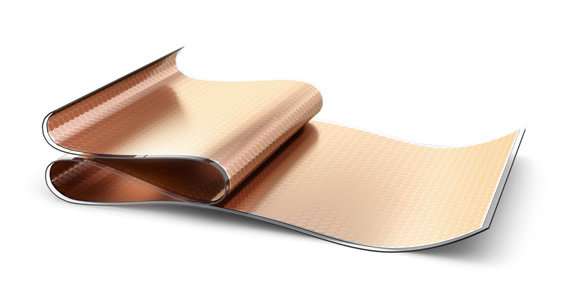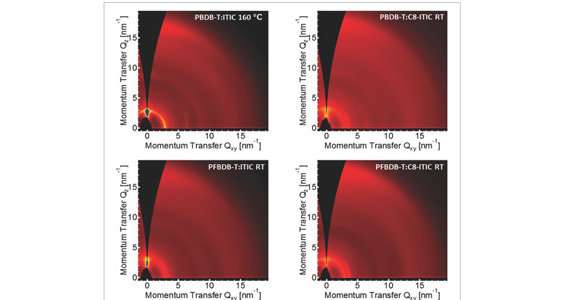Modifications to non-fullerene small molecule acceptor in organic thin film for solar cells improve efficiency

Scientists from the Imperial College London, Monash University, CSIRO, and King Abdullah University of Science and Technology have reported an organic thin film for solar cells with a non-fullerene small molecule acceptor that achieved a power conversion efficiency of just over 13 per cent.
By replacing phenylalkyl side chains in indacenodithieno[3,2-b]thiophene-based non-fullerene acceptor (ITIC) with simple linear chains to form C8-ITIC, they improved the photovoltaic performance of the material.
C8-ITIC was blended with a fluorinated analog of the donor polymer PBDB-T to form bulk-heterojunction thin films. The research was recently published in Advanced Materials.
Dr. Xuechen Jiao of McNeill Research Group at Monash University carried out grazing incidence wide angle X-ray scattering (GIWAXS) measurements at the Australian Synchrotron to gain morphological information on pure and blended thin films.
"By changing the chemical structure of the organic compound, a promising boost in efficiency was successfully achieved in an already high-performing organic solar cells" said Jiao. "GIWAXS gave us information about how the donor and acceptor molecules crystallised and aggregated within the thin films, as well as the orientation of the crystallites with respect to the substrates."
The technique is highly useful in investigating crystal structures of a range of soft matter thin films of conductive polymers, such as organic solar cells and organic transistors.
"The intensity of beam a the Australian Synchrotron provides a super high flux, that means information can be acquired in about three seconds compared with conventional XRD which takes about an hour," said Jiao.

"Changes in colour in two-dimensional GIWAX patterns represent changes in diffraction intensity which allow you to see how the unit cell changes."
In an experiment to examine crystalisation and aggregation behaviour, GIWAXS was implemented on single component thin films, ITC, C8-ITC, PBDB-T and PFDB-T with and without thermal annealing at 160 C .
Blends of C8-ITIC with donor polymer PFBDB-T demonstrated the best power conversion efficiency. The results suggested C8-CTIC molecules have a higher tendency to crystallise into ordered 3-D structures.
Improved molecular packing in C8-ITIC compared to CTIC was thought to contribute to superior charge carrier transporting behaviors, thus improved performance.
The paper authors, led by Prof Martin Heeney at the Imperial College London, also reported a new technique to synthesise the non-fullerene acceptor.
Other techniques used in the investigation included UV-absorption spectroscopy, cyclic voltammetry. atomic force microscopy electroluminescence and theoretical calculations.
There is a great deal of interest in non-fullerene acceptors because of their extended light absorption and tunable energy levels.
A group from the Chinese Academy of Sciences led by Wenchao Zhou recently reported in the Journal of the American Chemical Society last year that a molecular optimisation of 13 per cent in a non-fullerene thin film, of PBDB-T-SF and IT-4F.
More information: Zhuping Fei et al. An Alkylated Indacenodithieno[3,2-b ]thiophene-Based Nonfullerene Acceptor with High Crystallinity Exhibiting Single Junction Solar Cell Efficiencies Greater than 13% with Low Voltage Losses, Advanced Materials (2018). DOI: 10.1002/adma.201705209
Journal information: Advanced Materials , Journal of the American Chemical Society
Provided by Australian Synchrotron



















